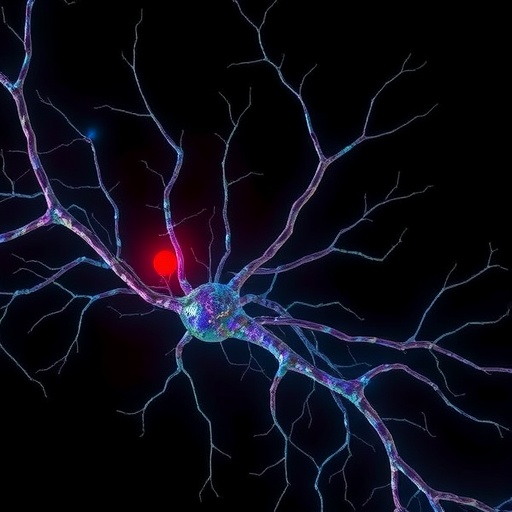In the realm of oncology, a persistent challenge has been the long-term neurotoxic consequences faced by patients undergoing chemotherapy. While these cytotoxic agents are critical in eradicating malignant cells, their collateral damage to the nervous system significantly impairs patient quality of life. Recent groundbreaking research, published by Hew, Maierhof, Ivanov, and colleagues in Cell Death Discovery, sheds light on an innovative neuroprotective intervention that targets c-Jun, a transcription factor implicated in neuronal stress responses. By leveraging human induced pluripotent stem cell (iPSC)-derived sensory neurons, this study provides compelling evidence that inhibiting c-Jun activity can mitigate chemotherapy-induced neurotoxicity, potentially revolutionizing supportive care in cancer treatment.
Chemotherapeutic regimens, particularly those incorporating platinum-based compounds and taxanes, are notorious for inducing peripheral neuropathies. These sensory neuron damages manifest as debilitating pain, numbness, and sensory loss, often irreversible and dose-limiting. Recognizing the urgent need for neuroprotective strategies, researchers have increasingly turned to molecular mechanisms underpinning neuronal injury during chemotherapy exposure. Central to these mechanisms is the activation of stress-associated transcription factors, among which the activator protein-1 (AP-1) family member c-Jun is a pivotal mediator.
The study meticulously explores the role of c-Jun in chemotherapy-induced neurotoxicity, employing an advanced in vitro model system where sensory neurons are differentiated from human iPSCs. This platform offers unparalleled fidelity to human neuronal physiology and enables precise dissection of molecular pathways involved in neurodegeneration. Notably, the harmonized differentiation protocol ensures the generation of functionally mature sensory neurons capable of responding to chemotherapeutic insults in ways that mimic patient-derived neuronal behavior.
Experimental exposure of these iPSC-derived sensory neurons to common chemotherapeutics led to marked c-Jun phosphorylation, signifying activation of the AP-1 pathway. Downstream effects of this activation included dysregulation of neuronal viability pathways, cytoskeletal destabilization, and induction of pro-apoptotic signals. These molecular events paralleled hallmark features of chemotherapy-induced neuronal injury observed clinically, validating the relevance of this in vitro framework.
Crucially, the research team demonstrated that pharmacological inhibition of c-Jun, using specific small molecule inhibitors, significantly attenuated the neurotoxic phenotype induced by chemotherapy agents. Treated neurons exhibited preserved axonal integrity, reduced apoptotic markers, and restoration of electrophysiological properties. These findings underscore the therapeutic potential of targeting c-Jun as a node for neuroprotection without compromising the cytotoxic efficacy against cancer cells.
Mechanistically, c-Jun acts as a transcriptional regulator of genes involved in neuronal death and survival. Upon chemotherapeutic stress, its enhanced phosphorylation orchestrates a transcriptional program favoring neuronal apoptosis and axonal degeneration. By interrupting this signaling cascade, c-Jun inhibitors recalibrate the balance towards cell survival and functional maintenance. This novel interventional approach addresses a critical unmet need by offering a targeted means to shield sensory neurons during aggressive chemotherapy.
Beyond the cellular and molecular insights, the study outlines the translational implications of these discoveries. Given the challenges of directly assessing neuronal damage in patients, the iPSC model offers a platform for drug screening and personalized medicine. Clinicians could foreseeably use patient-derived iPSC neurons to predict susceptibility to neurotoxicity and tailor neuroprotective strategies accordingly. Furthermore, c-Jun inhibition presents opportunities for co-administration with existing chemotherapeutics to preempt sensory neuropathy, potentially enabling higher dosing and improved cancer eradication rates.
Notably, the safety profile of c-Jun inhibitors remains a paramount consideration. The researchers address this by demonstrating that moderate inhibition of c-Jun does not impair general neuronal function nor interfere with chemotherapy-induced tumoricidal activity in parallel tumor cell assays. This selective neuroprotection without undermining anticancer efficacy suggests a promising therapeutic window for clinical development.
The study’s comprehensive approach integrates transcriptomic analyses to delineate gene networks modulated by c-Jun during neurotoxicity. These data reveal a concerted upregulation of inflammatory pathways, oxidative stress responses, and apoptotic effectors—all attenuated upon c-Jun blockade. Such integrative molecular profiling paves the way for identifying adjunct targets and combinatorial therapies to further enhance neuroprotection.
In addition to sensory neurons, peripheral glial cells contribute substantially to neurotoxicity pathogenesis. Although the current work focuses on neuronal populations, future research inspired by these findings could explore whether c-Jun inhibition also benefits glial cells, thereby broadening the scope of neuroprotective strategies.
Given the complexity of chemotherapy-induced neuropathy, incorporating patient stratification based on genetic polymorphisms influencing c-Jun pathway activity could refine therapeutic application. Pharmacogenomic insights combined with iPSC-based modeling represent a frontier for personalized interventions aimed at mitigating chemotherapy’s sensory sequelae.
Importantly, this study highlights the value of iPSC technology to model human-specific neurotoxic effects, something not fully recapitulated in traditional animal models. This advancement not only accelerates mechanistic understanding but also enhances the translational relevance and ethical acceptability of preclinical research in neuro-oncology.
As the incidence of cancer continues to rise globally, improving survivorship by minimizing treatment-related morbidities grows ever more critical. The ability to preserve sensory neuron integrity during chemotherapy through targeted c-Jun inhibition emerges as a beacon of hope for patients struggling with neuropathy-induced disability.
Future clinical trials will need to validate these preclinical findings, optimize dosing regimens, and monitor for unanticipated off-target effects. The evolving landscape of targeted therapies and supportive care interventions represents an exciting epoch where molecular insights converge with clinical innovation.
Ultimately, this seminal work by Hew et al. marks a meaningful stride toward mitigating chemotherapy-induced neurotoxicity. By harnessing cutting-edge stem cell models and precision molecular targeting, it opens new vistas for enhancing cancer patient care and quality of life worldwide.
Subject of Research: Chemotherapy-induced neurotoxicity and its mitigation via c-Jun inhibition in human iPSC-derived sensory neurons.
Article Title: c-Jun inhibition mitigates chemotherapy-induced neurotoxicity in iPSC-derived sensory neurons.
Article References:
Hew, L., Maierhof, S.K., Ivanov, A. et al. c-Jun inhibition mitigates chemotherapy-induced neurotoxicity in iPSC-derived sensory neurons. Cell Death Discov. 11, 529 (2025). https://doi.org/10.1038/s41420-025-02847-5
Image Credits: AI Generated
DOI: 13 November 2025




